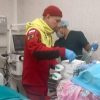It was a message shorn of festive cheer that no prime minister would want to deliver.
Yet faced with a new, rapidly spreading mutated strain of the coronavirus and a buckling NHS, Boris Johnson announced on Saturday that Christmas was cancelled for 17.7 million people in London and the south of England.
After a week which saw hospital after hospital cut routine operations, with some only able to accept patients with life-threatening conditions, the prime minister said he had “no alternative” but to act against a mutation that was “up to 70% more transmissible” than earlier versions.
“Given the early evidence we have on this new variant of the virus and the potential risk it poses, it is with a very heavy heart I must tell you we cannot continue with Christmas as planned,” Johnson said.
Johnson U-turn leaves nation’s plans for Christmas in tatters
Read more
From midnight on Saturday, people in London, the south-east and east of England including Kent, Buckinghamshire, Berkshire, Surrey (excluding Waverley), Gosport, Havant, Portsmouth, Rother, Hastings, Bedford, Milton Keynes, Luton, Peterborough, Hertfordshire, and parts of Essex will be under new tier four restrictions, similar to the last national lockdown, where non-essential shops are closed, people should stay at home and work from home, and individuals can only meet one person from another household outdoors.
“Across the rest of the country, the Christmas rules allowing up to three households to meet will now be limited to Christmas Day only, rather than for five days,” Johnson said.
Even by standards of the Johnson government, it was a dramatic U-turn. For weeks, ministers have held the government line that allowing three households to travel across the UK to mix in a Christmas bubble would not affect the spread of the virus.
The libertarian wing of the Conservative backbenches has bridled against the tiered restrictions, asking for exemptions for rural areas.
Yet critics said that while the government tried to carry on as normal, keeping schools open under threat of legal action and parental prosecution, the government’s figures showed infections soaring among secondary school-age children and emergency departments filling up.
Leading medics who spoke to the Observer last week described hospitals at breaking point from the pressure of rapid rises in Covid patient numbers, winter illnesses and exhausted staff. Last Wednesday, when the government announced that 18,469 Covid patients were in hospitals across the UK, not much lower than the 21,683 at the peak of the first wave, Johnson heckled Labour leader Sir Keir Starmer for suggesting that easing Christmas restrictions would cost lives.
“I wish he had the guts to say what he really wants to do, to cancel the plans people have made and cancel Christmas,” Johnson said at prime minister’s questions in the House of Commons. “We don’t want to criminalise people’s long-made plans.”
Play Video
4:05
Johnson announces tier 4 for London and scraps Christmas mixing rules – video
Three days later, at a press conference flanked by Chris Whitty, the chief medical officer for England, and Patrick Vallance, the chief scientific adviser, the prime minister said he “bitterly regrets” the changes.
“Without action, the evidence suggests that infections would soar, hospitals would become overwhelmed and many thousands more would lose their lives,” he said.
“We, of course, bitterly regret the changes that are necessary but when the facts change, you have to change your approach. The briefing that I had yesterday about this mutation of the virus and particularly about the speed of transmission was not possible to ignore. When the virus changes its method of attack, we as a country have to change our method of defence.”
Vallance said the new variant of the virus was first detected in September and by 9 December accounted for 62% of all new cases in London.
It is vital that people do not travel between regions, Whitty said. While the new, more transmissible variant is widespread in the south, it represents only 5% of cases in Yorkshire and the Humber.
“If they were to go with this new variant unwittingly to an area that has a low prevalence … that would be a significant risk to the area they went to,” he said. “Because we understood this information at the back end of this week that we advised you really do have to act at this stage, because otherwise every area of the country will get this very quickly, and then none of them will be able to hold things with tier three and tier two.”
There is no evidence that the new strain is more dangerous, Vallance said, although there are theoretical reasons why it might affect the body’s immune response.
“Our working assumption, from all of the scientists, is that the vaccine response should be adequate for this virus,” he said. So far 350,000 people have had their first dose.
The prime minister said they had been puzzled as to why tier three restrictions in Kent had not had the same results seen in the north-west.
“It’s not until yesterday, when we have seen this data on transmissibility that we really got the answer that explains it,” he said.
Covid tier 4: what are the new restrictions for London and south-east England?
Read more
Hospital admissions in London, the south-east and east have been rising by more than 700 a day, and senior frontline doctors in emergency departments across England and Wales say A&E staff are having to deal with Covid patients at levels seen during the first wave of the pandemic, but without the extra help they had in April.
Regional leaders of the British Medical Association, the Royal College of Nursing and the Intensive Care Society told the Observer the strain on NHS workers was being underestimated.
Simon Walsh, a consultant in emergency medicine in north-east London and deputy chair of the BMA’s UK consultants committee, said: “We have a workforce which every day is being broken down bit by bit by this unbearable pressure and NHS staff are going to pay the price of that. And I’m afraid the public are going to pay the price of that if the government is not honest about the scale of the problem, and the need to reduce routine work to allow us to get through this peak.”
A&E departments are also dealing with non-Covid patients, and lack of capacity forced hospitals in London, Wales and the Midlands to cancel operations or declare major incidents in recent days: Whipps Cross in east London, University College London hospital, the Grange in Cwmbran, East Kent hospitals and the Barts Health NHS Trust have all been trying to deal with lack of bed space.
Queen’s hospital in Barking is understood to have 95% of its 900 beds occupied and has closed four operating theatres for routine procedures.
Margaret Hodge, the MP for Barking, asked why the Nightingale hospitals were not being reopened. “The situation is absolutely dire. [The local NHS] told us they stopped doing cataracts, hips and knees and they’re still at 95% capacity. People are in hospital for longer and the hospitals are filling up. What happens next?”
In March the NHS dealt with the huge rise in cases by stopping all routine operations, and reassigning staff to Covid wards. The national lockdown eased pressure on A&Es because fewer people were injured doing extreme sports, DIY, or in work or alcohol-related incidents. And most winter viruses had fallen to background levels by spring.
But reduced restrictions means emergency departments are as busy as last year. The NHS is trying to clear the enormous backlog of routine surgery, so those staff are not working on emergency and critical care wards.
And although flu is at unusually low levels, the second wave of Covid has come on top of annual winter pressures that regularly put the NHS into a beds crisis. This year, there are no patients waiting on trolleys in corridors – Covid infection controls mean patients are kept in ambulances for 12 hours or longer.
Lisa Elliott, the RCN’s regional director for London, said the capital was short of 9,000 nurses before the pandemic.
“This is being compounded by staff sickness due to Covid-19, and many nursing staff are still suffering from the physical and emotional impact of nursing during the first wave,” she said. “My members are telling me that are totally exhausted and that they are really worried about what awaits them in the new year.”
Even in the north west, where pressure is easing, the situation remains serious. Shond Laha, a critical care consultant in the region, said: “The second wave has been much worse than the first.
“There’s a concern nationally that we’re seeing the number of nurses who want to be redeployed go down, understandably, because they don’t want to work in intensive care because it’s a stressful environment – hot, sweaty, claustrophobic.” Many agency nurses also did not want to work in critical care, he said.
In Wales, Mark Drakeford brought forward new lockdown restrictions to start at midnight last night, and scrapped the planned relaxation of Christmas rules.Phil Banfield, who chairs the BMA consultants’ committee in Wales, said patients had been waiting in ambulances for an average of eight hours until space became free in emergency departments.
Tier 4 rules
From Sunday areas in the south-east of England that are now in tier 3 will be moved into a new tier 4, which effectively means returning to the lockdown rules of November.
-
The new tier 4 restrictions will apply in all tier 3 areas in the south-east: Kent, Buckinghamshire, Berkshire, Surrey (excluding Waverley), Gosport, Havant, Portsmouth, Rother and Hastings.
-
It will also apply in London (all 32 boroughs and the City of London) and the east of England, covering Bedford, Central Bedfordshire, Milton Keynes, Luton, Peterborough, Hertfordshire and Essex (excluding Colchester, Uttlesford and Tendring).
-
People in tier 4 should not stay away from home overnight and people from other areas are advised not to visit tier 4.
-
Non-essential shops, gyms, cinemas, hairdressers and bowling alleys in tier 4 areas are to close for two weeks.
-
Plans to allow up to three households to meet over the Christmas period from 23 December to 27 December have been scrapped for tier 4. Instead, people will be restricted to meeting just one other person from another household in an outdoor public space.
-
In the rest of England, up to three households will be able to meet, but only on Christmas Day.
-
Exemptions to the “stay at home” message which applied in the November lockdown will also apply in the new tier 4 – including support bubbles, childcare bubbles and children whose parents are separated.
-
People will be allowed to travel for education, childcare and to go to work if they cannot work from home, and they will also be permitted unlimited outdoor exercise.























































Свежие комментарии